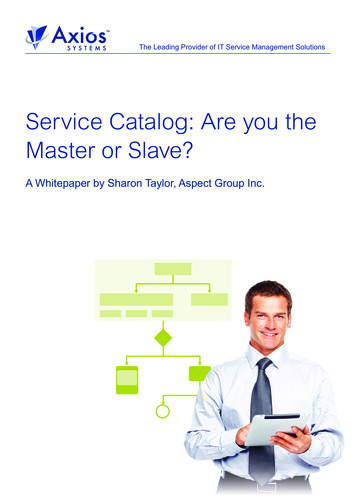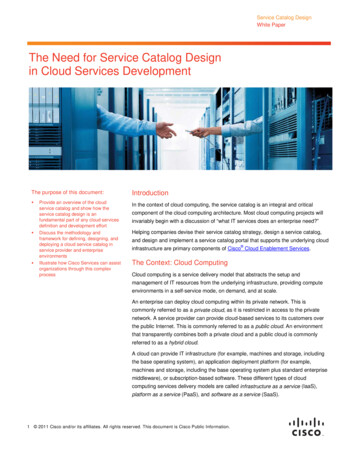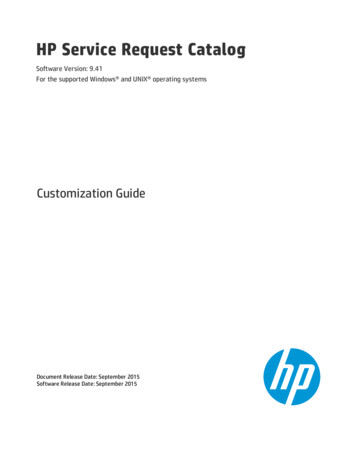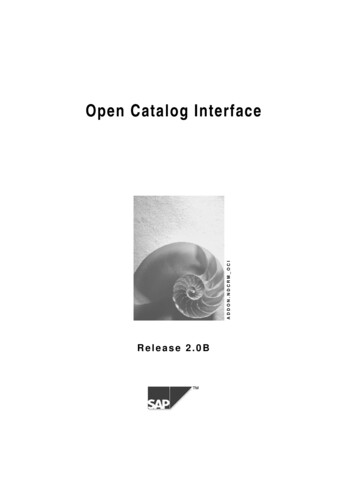
Transcription
The Leading Provider of IT Service Management SolutionsService Catalog: Are you theMaster or Slave?A Whitepaper by Sharon Taylor, Aspect Group Inc.
Service Catalog: Are you the Master or Slave?IntroductionS er vic e (s ur -v is) - An ac t ofhelpfu l activity; help; aid: t o dosome on e a se rvice.C atalog (k at-l-a w g, - og) - Alist o r record of s er v ic es whic har e systema tica lly ar r angedand o ften includ ing des c r ipt iv ema teria l.Ma na ge m ent (m an- i j - m uh- nt ) T he act or ma nn er of m anaging;hand ling dire ctio n, or c ont r ol.It’s a fact that the quality of the Service Catalog can greatly affect thebusiness’s perception of IT.A Service Catalog is the means by which we, as IT service providers,articulate what we can do for our business customers. It seems a simpleenough concept yet so many of us get it wrong over and over again.Business demands are pushing IT to the limit, so IT needs to look for betterways to meet those demands.Deploying a simple and accurate Service Catalog will help your ITorganization effectively manage service demand and gain credibility withinthe business.ServiceCatalogManagementHelpful activityA list of items forsale systematicallyarrangedControlled handlingContentsIntroduction What is a Service Catalog? Why is a Service Catalog important? Challenges of setting up a Service Catalog Industry best practice – some practical advice Getting started or improving a Service Catalog A real life example Return on Investment (ROI) 5 tips for implementing a Service Catalog About Axios Systems2
Service Catalog: Are you the Master or Slave?What is a Service Catalog?The IT ServiceManagement (ITSM) bestpractices teach us thatthe single most importantthing we must do right isto provide value to thebusiness. Otherwise,there is no reason for usto expect the loyalty of ourcustomers.Doing this important task involvesa few principles that do not changeregardless of what services we areproviding to the business. We must:1.Articulate our value in businessterms that our customersunderstand.2.Be able to demonstrate thisby measuring and reporting itregularly to the business.3.Understand the business needsand be responsive to changes.4.Provide services that are costeffective, relevant and reliable.There is an old saying that “you can’tmanage what you can’t measure”.While this is still true today, it shouldalso state that if the business doesn’tsee the connection to what we manageand measure, then it becomes anirrelevant exercise. The ServiceCatalog is the means by which wearticulate what we manage andmeasure. It is the hidden power of howwe set the customer’s expectations andexceed them.If you are shopping for a garment, youaren’t likely to ask or care about: How many people did it take tomake this? How was the fabric chosen? How many of these were made inthis color? How long did it take to make?What you really want to know is how itwill work for your needs: Does it suit my purpose? Does it come in my size? Is it washable or does it need drycleaning? Is it within my budget?2bAv uttonailaPeabrmle djusFutinansw ablenCo edt p hite e cuctollto,breffsMnarslafto s an ue,No chin abrrsdiediro e w c fo taywrninrasink andiha bre n plglblaeaatnebreha ceed lesis ckbleedtantcomfortKnowing your customerneedsIn the above example, there are afew characteristics of the shirt thatwill be important to some customers,not critical to others, and not at allimportant to yet others. This indicatesthat the way a customer uses a serviceis as important as the service itself.The last two characteristics – machinewashable and no ironing needed – willbe absolutely critical to customerswho prefer to self-launder their shirts.Others may prefer to use professionalcleaners and so this is an irrelevantpart of the service for them.For the sellers of the shirt, knowingthis allows them to cater to individualcustomer needs by emphasizingservice characteristics that appealto the business need and thereforeprovide value, while using the sameservice to appeal to another customer’sneeds in a different way.So, the way the service is depicted inthe Service Catalog carries a majorsignificance for appealing to customerneeds. This will not only please existingcustomers, but may be the reason newcustomers are attracted to you as aservice provider!Figure 1 - A Service Catalog is intended to show the customer how the product suits their needs.3
Service Catalog: Are you the Master or Slave?ITIL defines a Service Catalog withtwo aspects, and although whilenot specifically defined in ITIL asan element, access to the BusinessService Catalog through a UserRequest Catalog can also be providedin a variety of ways that suit theprovider’s customer base:1.The Business Service Catalog –defines the IT services deliveredto the customer together with therelationships to the business unitsand processes.This is the business customer’smenu. It describes what is on offer,when, and how much it costs. AnIT service provider can illustrateservices in a variety of wayssuch as core services, servicepackages, bundled services, etc.2.User Request Catalog – as partof maturing ITSM practices,many providers have self-serviceofferings that provide access toknowledge, services and support.For example, many businesscustomers are familiar with onlineshopping and can benefit froma web-based User RequestCatalog for those services that thebusiness prefers its users to selectfrom on an ad hoc basis. Thereare increasingly innovative waysthat service providers use to maketheir Service Catalog availableand interactive for the businesscustomer.Figure 2 - The User Request Catalog provides a familiar shopping cart environment to increasecustomer adoption Support – every service shoulddescribe how the businesscustomer should report problemsor make requests. Service Conditions – this shouldset the expectations for anyspecific terms of usage andoperational maintenance andchange periods. Cost – every service shouldestablish its cost, whether theorganization’s financial model is tocharge the customer or inform thecustomer of its cost to deliver. Features and Functions – a briefdescription of the features andfunctionality of the service. It’s wiseto describe these in terms of thevalue these bring to the customer.How it is structured and presentedvaries among customers andtechnologies, however, there aresome common elements that anyorganization using best practicesshould consider as part of their ServiceCatalog: Related Services – links to otherareas of the Service Catalog thatprovide complimentary servicesthat the customer might find useful,or that form part of a core servicepackage. Service Description – what theservice is in business language. Service Levels – to avoidmisunderstandings, every servicein the Service Catalog shouldclearly describe the agreed servicelevels.4News or Alerts – this can helpcustomers be aware of pendingchanges, maintenance activitiesor planned enhancements to theservice. This can also include newservices that are planned.3.The Technical Service Catalog– defines the technical view ofconnecting supporting servicecomponents that underpin thebusiness service. Sometimescalled the “IT view,” this area ofthe Service Catalog assemblesthe constituent components thatcomprise a service and ensurethey are mapped to fulfilling abusiness process need.This area of the Service Catalogwill often be virtual rather thanphysical and will link to variousrepositories of information suchas the Configuration ManagementSystem (CMS), Service LevelAgreements (SLAs), OperationalLevel Agreements (OLAs), Securityand Access information, activedirectories, service utility andwarranty information, etc.The business customer shouldnever need to access this levelof the Service Catalog. Its valuelies in helping IT to connect thecomponents of each service fromend-to-end.
Service Catalog: Are you the Master or Slave?Why is a Service Catalog important?There are many reasons why a ServiceCatalog is important but among themost compelling are that it: establishes a clear view of whatyou can do for existing ANDpotential customers. creates a common understandingof what a service is, and whatcharacteristics it has. illustrates your unique style anddifferentiation from competitors inservice offerings.allows you to develop core andcustomized service packages foryour customers, thereby providinggreater value, and to identifyservices cost efficiencies.provides a basis for understandingbusiness demand patterns whichare then consistently interpretedfrom a service view. provides a platform for users toself-serve and request services. sets expectations about howservices should be used and howmuch they will cost. It reflects howmuch the service will cost, not theprice of components.5Service Catalog benefitsNo matter the size or complexity ofyour Service Catalog, if you follow bestpractice advice, your Service Catalogwill provide significant benefit. It will: help manage your customerexpectations by providing clarityon what you do and don’t do forthem, as well as what you includeand don’t. help manage services from abusiness-focused and businessbased delivery mindset. allow you to document andmanage services from an end-toend perspective and capture thetrue cost of service provision. allow you to demonstrate your ROIto the business customer. demonstrate a professional,responsible approach by IT toservice management from thebusiness value perspective.Most importantly, having a wellstructured and functioning ServiceCatalog can link business needsdirectly to IT services and then into thetechnical infrastructure. This improvesthe awareness, understanding andpositive cultural behaviors that makeeffective Service Value Managementpossible.If you struggle to understand yourbusiness customers, to keep theirloyalty and satisfaction, or you needhelp attracting new customers, aService Catalog could be your nextmajor step in achieving IT serviceexcellence.
Service Catalog: Are you the Master or Slave?Challenges of setting up a Service CatalogThinking a different wayAvoiding tool blindnessAdoption and useFor many IT organizations, setting up aService Catalog requires them to thinkin a different way. Services becomemore about the business needs thanabout the underpinning technologycomponents. IT must talk to customers,and see services from a non-technicalstandpoint. This can be a challengebut one that must be overcome toget a meaningful Service Catalog inplace. The first way this manifestsis in defining services themselves.This must be understood, agreed andrepresent a business-defined view.Service Catalog technology solutionswhich require a standardized definitionshould be considered. They help toensure that both the business and ITare consistent, as services are createdand modified during their servicemanagement lifecycle.There are a lot of technology solutionsin the market that can help with ServiceCatalog Management. What noneof these tools can do is replace yourknowledge of the customers and whatappeals to them as value. Tools arecritical to automate, present, collateand trend information, but without theinvestment of customer knowledge,feedback and a sense of commitmentto Service Catalog Management, toolswill not provide the innovation anddifferentiation that they should.This applies to both the customer andto the IT organization. The spirit andintent of a Service Catalog is to liveup to the customer’s expectation byproviding the services and quality thatare stipulated in it. Too often, thereis lack of customer understanding oracceptance that the Service Catalogrepresents the definitive availableservices, or, worse, lack of awarenessby the IT organization that this is whatthe customer pays for, no more, noless. This allows customers to expectmore than they pay for, and for ITorganizations to try to deliver it.6The above situation is purely culturaland driven by behaviors that supportthe idea that the Service Catalog isjust a document and if those needs gobeyond what is in it, then either partywill do its best to meet an unrealisticexpectation. This has consequencesthat go well beyond poorly managedexpectations. These behaviors have atangible cost to IT and to the businessbottom line.
Service Catalog: Are you the Master or Slave?Industry best practice – some practical adviceThe Service Catalog should beconsidered a critical asset for IT and forthe business. It should be the place thatboth the customer and provider refer towhen considering business needs. It isbest managed as part of overall ServicePortfolio Management and should linkthrough the IT service lifecycle. Often, aService Catalog initiative will be startedas a project.This is a good point to considersoliciting the help of independentexperts who can conduct a workshopto help set the objectives and scope.An independent view will also helpestablish an open, neutral way to shareideas and possibly conflicting views.The validity and usefulness of theService Catalog relies on a solidfoundation of information andmanagement. Keeping the TechnicalService Catalog current and mappedto the Business Service Catalog willrequire links to other types of serviceinformation within the service lifecycle.Service LifecycleDependencyInformationService StrategyService PortfolioNew services in the pipeline being consideredDemand ManagementRetiring services transitioning out of supplyFinancial ManagementLinks to usage trends and necessary changes to theService Catalog services and terms of useLinks to service costing, supplier side costing andservice modelsService DesignService Design PackageService Catalog ManagementService Level ManagementLinks to the service structure, features, details,customer information, service utility and warrantyResponsible to update and manage the ServiceCatalog itselfLinks to SLAs, OLAs, supplier contracts and reportingService TransitionService Asset and ConfigurationManagementChange ManagementDirect links between the Technical Service Catalogand the CMS for component, dependency and serviceasset informationDirect links to service warranty and servicestransitioning in and out of supply as well as tomaintenance of the Service Catalog itselfService OperationService DeskEvery service in the Service Catalog should provideinformation on how to get support, make requests, askquestions and provide feedbackContinual Service ImprovementService MeasurementThe Service Catalog should link to the organizationreporting such as a Balanced ScorecardThe Service Catalog should form part of the serviceprovider’s CSI initiatives and solicit feedback fromcustomers about what improvements will strengthenits use and valueTable 1 - How the Service Catalog links to the different elements within the IT service lifecycle.7
Service Catalog: Are you the Master or Slave?Getting started or improving a Service CatalogDeveloping a ServiceCatalog does not need tobe a massive undertakingall at once. Follow ServiceDesign practices to ensurethat all requirements areunderstood and a formalprocess is used to designthe Service Catalog.c. Agree on the definition of aservice.Vague or convoluted definitionsdo little to help your customerunderstand your value. Be straightforward, use plain language andbe consistent. A standard formatfor service definitions shouldbe used to ensure that over time,definitions are consistently used inaccordance with how they havebeen agreed.d. Organize the informationyou already have.Planning is the first and mostimportant step. Whether you wantto incrementally build your ServiceCatalog or go for a big bang, there aresome critical steps along the way thatyou are wise to include:1.Carry out a Service Catalogworkshop:a. Ask the right questions.Who are your customers?What are their most importantbusiness processes?Are your services mapped tothose?Are your services currentlydefined?Do you have SLAs for yourservices?b. Involve your businesscustomers.Before you do anything else, talkto the business about what theywould find valuable in a ServiceCatalog. Understand how yourcustomers use the service. Toooften, IT specialists believe theyhave all the answers only to findout they did, but not to the rightquestions!8List the existing services you haveand map these to your businesscustomers. Classify servicesaccording to how they map tobusiness processes. This is a greatbeginning to the Business ServiceCatalog.2.List the dependencies each servicehas with:a.Third party suppliersb.Service levelsc.Business criticalityd.Customerse.Processesf.IT components3.Decide usage parameters suchas who will have access to theService Catalog and by whatmeans, who can authorizechanges to it, how often and howthey are made.4.Start with a reasonable numberof services first. Focus on someof the more critical businessprocesses to test your structureand usability.5.Make sure you know yourrequirements before investing inautomation tools. Be innovative.Think about linking indirect ITservices to the Catalog as well.This compels the customers to relyon a Service Catalog for all theirneeds.
Service Catalog: Are you the Master or Slave?A real life exampleAs with any ITSM improvementinitiative, it is critical to avoid thenotion that all ideas must be newones. The most successful companiesuse a Service Catalog and start bygathering experience from what isalready within their organizations.The cultural shift can be made easierby adapting already good practices.Many companies have adoptedService Catalog structures from thebusiness itself and how they promotetheir services to the end customers.I have often guided some of my owncustomers to use this method and onein particular had significant positiveresults in a short time frame.Figure 3 - Users can access information or services available to them in a number of ways.Using existing bestpracticesAdopt a style useful to thebusinessThe business has a customer Catalogthat is very sophisticated and popularwith end customers. The businesshas refined it over many years andcustomer satisfaction surveys revealthat one of the most appreciatedbenefits customers enjoyed was theun-cluttered, concise, and consistentlystructured Catalog. The businesscustomers reported that it was easyto find what they needed and that allthe information they required to makea choice was provided. Each item wasorganized and presented in an intuitiveand consistent way, and could betailored to the specific customer profile.It was a predominant reason whycustomers remained customers!The IT organization wisely chose toadopt this style and requested thatthe business became part of theproject team to help them adopt this.This made the agreement on servicedefinitions, content, and structure mucheasier to gain, since the businesswas familiar with the concept. The ITorganization was able to utilize existingbase structural specifications and totest the concept using the businesstest environment. Additionally, the ITorganization was able to expand thescope of the Catalog to non-IT servicesand to leverage the technologicalplatform already supported by IT for thebusiness customer Catalog.9The organization has achieved thefollowing benefits: Consistent look and feel for theService Catalog that the businesswas familiar with. Lower implementation costsby leveraging base structuralarchitecture, platform and deliverymodel. Quick buy-in for the concept andthe use of familiar definitions andlanguage. Greater efficiencies by expandingthe inclusion of non-IT services. Re-use of already successfulsupport and Service LevelAgreement models. Greater awareness andacceptance by the business of ITservice needs for clear, consistentand committed use of the ServiceCatalog. Rapid ROI through cost-effectivedevelopment and implementationtime.
Service Catalog: Are you the Master or Slave?Return on Investment (ROI)Today, most service providers are underconstant pressure to demonstratetheir value to the business and todemonstrate an ROI. A Service Catalogcan accelerate ROI by promotingstandard, core and specialized servicepackages and avoid ad hoc serviceactivities that are commonly seenwhere the customer is not familiar withwhat IT services actually are. There areyears of published evidence showingthat the single most expensive partof IT cost of ownership is managingthe unscheduled, undocumented andunplanned support activities.MaturityUnplanned support costs012345COBIT Maturity scale5 tips for implementing a Service Catalog1Carry out a Service Catalog workshop:a Ask the right questionsb Involve your business customersc Agree on the definition of a serviced Organize the information you already have2List the dependencies each service has3Decide usage parameters4Start with a reasonable number of services first5Make sure you know your requirements beforeinvesting in automation tools10
AxiosFor more than 25 years, AxiosSystems has been committedto innovation by providingrapid deployment of ServiceManagement software. Withan exclusive focus on ServiceManagement, Axios is recognizedas a world leader, by the leadinganalysts and their global clientbase.Axios’s enterprise software,assyst, is purpose-built, designedto transform IT departments fromtechnology-focused cost centersinto profitable business-focusedcustomer service teams. assystadds tangible value to each client’sorganization by building on theITIL framework to help solve theirbusiness challenges.Axios is headquartered in the UK,with offices across Europe, theAmericas, Middle East and AsiaPacific. For more information aboutAxios Systems, please visit us:www.axiossystems.com@Axios Systems/axiossystemsAbout the AuthorSharon TaylorAspect Group IncSharon is well known andrespected in the ITSM globalcommunity. She is the former ChiefArchitect for ITIL and Presidentof the Aspect Group, a NorthAmerican based ITSM practiceprovider of training, consultancy,assessment and best practiceimplementation.Sharon also holds the positions ofITIL V3 Chief Examiner and Chairof the itSMF International.Sharon resides in Canada and hasmade many contributions to ITSMover the past 15 years as an authorof ITIL, white papers and variousITSM publications. In 2008, Sharonwas awarded the prestigious ITService Management LifetimeAchievement Award.In 2013 His Excellency SheikhMubarak Al Nahyan, Ministerof Culture, Youth and socialdevelopment presented Sharonwith an award for outstandingachievement to the IT servicemanagement industry.Her work is known across manycontinents.
ITIL defines a Service Catalog with two aspects, and although while not specifically defined in ITIL as an element, access to the Business Service Catalog through a User Request Catalog can also be provided in a variety of ways that suit the provider's customer base: 1. The Business Service Catalog - defines the IT services delivered









![Service Catalog-Spain.ppt [Modo de compatibilidad]](/img/19/servicecatalog-spain.jpg)
